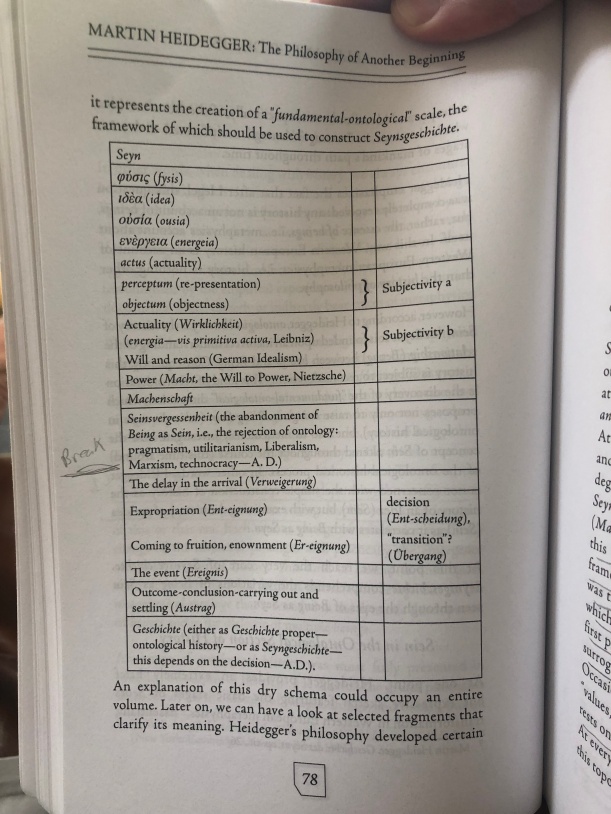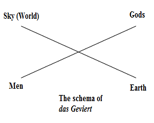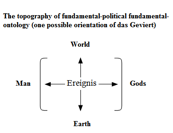I have my questions about his larger project, but his analyses of modernity and postmodernism are simply too good to ignore.
Birth of a Concept
- Three Ideologies
- Liberalism: the individual is the normative subject (this includes both free market capitalism and the Democratic Party. I am using “liberal” in a non-perjorative sense).
- Fascism: race or nation is normative subject
- Communism: Class
The second and third options failed, leaving liberalism in charge. Without any alternatives, liberalism is the norm. - 4th political theory: Dasein is the acting subject. We will explain more on this later.
- Postmodernism
- Global Market Society
- Globalism
- Technology
- Kingdom of Antichrist
- Global Market Society
- Heidegger and the Event
- The ancient greeks confused the nuances between pure being (Seyn) and a being (Seinende).
- Nihilism and the event
- The “Nothing” is the flip side of being and paradoxically reminds one of Being’s existence.
- Event: the sudden return of being.
Dasein as Actor
- What is the nature of freedom?
- Classical Liberals defined freedom as “freedom from.” There should be no ties on an individual’s will.
- It is these individuals, acting alone but taken as a whole, who form the circle of liberal action.
- Lacking a telos by definition, liberalism is hard-pressed to explain what we have freedom for.
- All political theories have an acting subject.
- Classical Liberals defined freedom as “freedom from.” There should be no ties on an individual’s will.
- Dasein as subject.
- Dasein is a way to overcome the subject-object duality. It is inzwichen, the “between.”
- Hidden Racisms
- Is “progress” racist? Maybe. Progressive societies have an implicit judgment that other societies, who do not hold such views, are inferior.
- The only true human rights are those enshrined by global capitalism, democracy, individualism.
- Ethnos: A community of language
- Racist societies, whether Nazis or American neo-liberals, reduce society to a concept like race, blood, market.
- A better reduction, if reduction it is, is language.
- Language allows for an “accommodating landscape” (Gumilev). It is the matrix of a “Life-world” (Husserl).
- Ethnicities generate the criteria by which they are judged (Dugin 48).
- The village-state is an alternative to the metropolis.
Critique of the Monotonic Process
Liberal ideology is necessarily evolutionary. The concept of progress takes one from barbarism to technologism and the more refined way of life of the markets.
Monotonic process: the idea of constant growth, accumulation, steady progress by only one specific indicator (60). In other words, in a system only one value (x) grows. Only one thing (or a small group of things) accumulates. Applied to either machines or biological life, this is death.
The Gift
In traditional societies surplus was always sacrificed or given away. Thus, festivals.
Nietzsche: if there is growth in life, the movement towards logos, then the balance of the nocturnal Dionysian world exists as well (65).
Modern political options have all seen progress and time in a linear fashion. Even more so, because of time there must naturally be progress. By contrast, Dugin suggests that
T1: Time is a social phenomenon with its structures arising from social paradigms (68).
By this he wants to safeguard the idea that there can be “interruptions” and reversals in the flow of time. History does not simply teach the march of capitalism upon earth (borrowing and adapting Hegel’s phrase).
Nevertheless, and perhaps unaware, Dugin remains close to the linear view. He does note that time is “historical” (70) and from that draws a very important, Heideggerian conclusion: it cannot be objective.
Why not? The acting subject, the historical observer (whom we will call “Dasein,” but this is true also of the individual in liberalism) is finite. He doesn’t have a god’s-eye view on history.
Of course, that’s not to say it can’t be real or reliable per the observer, but we don’t have the Enlightenment’s dream of a god’s-eye application of reason to reality.
Global Transition and its enemies
- What is the New World Order?
- It is a “universalism of free market economics, political democracy, and the ideology of human rights” (71).
- From the American point of view: a strong imperial core with the periphery divided and fragmented.
- Creation of multilateral unipolarity.
- Promotion of accelerated globalism and swift de-sovereignisation of nation states in favor of a global United States.
- Global democracy is a self-generating virus (Stephen Mann).
- The World Order from a non-American point of view
Conservatism and Postmodernity
Paradoxes of Freedom
- Liberal freedom in action is the freedom to choose TV stations.
- If I am “free,” am I free to say no? Can I say “no” to freedom?
- Liberalism cannot allow this, which means there is no alternative to it.
- Df. conservatism = repudiation of the logic of history. True conservatism means that history isn’t necessarily moving towards a moment of universal global markets.
- Fundamental Conservatism: Traditionalism (86ff).
- Opposes “time.” Specifically, it does not accept the argument that progress is necessarily good.
- Status quo conservatism: liberal conservatism.
- It is liberal in that it says yes to modernity, “but at each stage it attempts to step on the breaks” (91).
- Left Wing Conservatism (Social Conservatism)
- Eurasianism: an umbrella of subordinate conservatisms
- There is no single historical process.
- Every nation has its own historical model and moves in its own rhythm.
- Fundamental Conservatism: Traditionalism (86ff).
Transformation of the Left in the twenty first century
- The Leftist Philosophy in Crisis: three varieties
- Old Left:
- Orthodox Marxists.
- Stuck in concepts anchored in the Industrial Revolution. Really couldn’t adapt to hyper-technological ages.
- Fundamentally wrong about historical dialectic.
- Social Democracy:
- Income tax, government in the private sector, free medicine; traditional “liberal” mores.
- Social Justice + Market expansion
- Orthodox Marxists.
- Left Nationalists
- New Left: anti-globalism, postmodern, post-human
- Utilized Marxist analysis of ideology as “false consciousness” to explain society, philosophy, economy.
- Bourgeois society is a result of superstructures.
- Old Left:
Ontology of the Future
- Three ecstasies of time (Heidegger). Normally, we would say that the future “lacks the most being.”
- Immediacy (there is/there is not)
- Documentary (there was/there was not)
- Probabilistic (there will be/there will be not)
- Perception and Being: Kant denied that by mere perception we have access to the thing-in-itself.
- Therefore, if the being of the present is put in doubt, then all three moments become ontologically unproveable.
- From the perspective of pure reason, the future is the phenomenon, and hence, it is (157).
- Kant puts time nearer to the subject and space nearer to the object.
- Therefore, time is subject-ive.
- It is the transcendental subject that installs time in the perception of the object.
- Time is like music (Husserl); the resonance lingers.
- The future is continuous in the present.
- The future is the tail-end of the present.
- Consciousness
- That which is beneath the level that the nature of time is perceived.
- In the present consciousness perceives itself and nothing else.
- Short circuit: perception of pure being as the presence of the subjectivity of consciousness. Transcendental subjectivity (158).
- Causes all kinds of dualities to be born.
- The creation of time stops this trauma.
- “Intentionality and logical judgments are all rooted in this evasion of the perception of pain of the void whereby consciousness becomes aware of itself” (158).
- Pure presence of the same is unbearable.
- Time constitutes consciousness running from the unbearable confrontation with itself.
- Initial Conclusions
- Time precedes the object.
- The world is created by time (or time through God)
- Time’s manifestation is as self-aware subjectivity.
- The future is predefined by the structure of the subject.
- Organizing time: circular, traditional, material.
- Society and Time
- Every society is a separate act of consciousness in temporal and rational horizons.
- Every society has its own history.
- Thus, time is rooted in geography.
- Thus, globalization, in canceling out traditional differences, erases time.
- Therefore, with no time, the “short circuit would grow exponentially without the possibility of being dissipated.
- Cataclysm.
- Every society is a separate act of consciousness in temporal and rational horizons.








